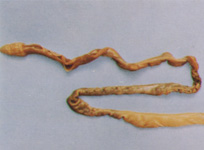Multi-opercular Tongue Worm belongs to the Balanoglossidae family of Enteropneusta class. It was discovered in 1965 by a group of Chinese biologists led by Zhang Xi. Being a specific invertebrate native to China, it is mainly distributed in the intertidal zone from the north of Bohai Sea to the south of Yellow Sea.
 |
|
It is soft, long and thin, similar to the worm. The conoid body is about 1/50 of its full length, and the collar has the same length as the body. There is a strip of lognitudinal groove in the centre line on the back of the lower body. Its body is light orange. The body stipe on the base is surrounded by the fore-edge of collar, and there is an obvious gap at the juncture between rhynchodaeum and center of the upper belly. There are many longitudinal goffers on the collar, of which there is a dark-colored fibrous loop respectively at 1/3 section on the two end; the section between two loops is light-colored. At the rear edge of collar is a strip of protuberant operculum, close to whose forepart is a strip of rufous annular belt, which is quite obvious setted off by light orange collar.
The hepatic section is about 1/10 of the full length, in various colors including, from front to rear, brown, mineral yellow and green. It has as many as 100 to 130 hepatic pouches, arranged orderly in two rows. The front and back parts of the hepatic section are small, while the middle part is long. The tail part, with a length of more than half the full length, is provided with external ring muscles. The opening of its anus is at the tail end. The entire tail section is in the color of light brown or yellow.
The reproduction section of the female is 1/3 of the full length. The length of branchia occupies 1/5 of that of genital alae. Its opercular apertures totals up to 130 to 160. Its two genital alaes are symmetrical, starting from the rear edge of collar where the two alaes are separated from the forepart of branchia.The female's genital alae at the back end of branchia section are in purple brown, while male's is in the colors of scorch or brick red.
